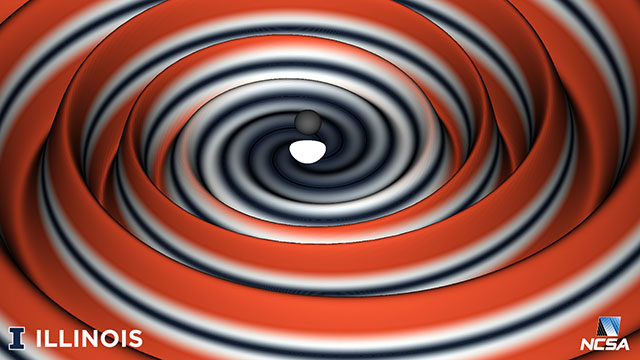Nov. 30 — At the National Center for Supercomputing Applications (NCSA), undergraduate SPIN (Students Pushing INnovation) intern Daniel Johnson joined NCSA’s Gravity Group to study Albert Einstein’s theory of general relativity, specifically numerical relativity. Daniel has used the open source, numerical relativity software, the Einstein Toolkit on the Blue Waters supercomputer to numerically solve Einstein’s general relativity equations to study the collision of black holes, and the emission of gravitational waves from these astrophysical events. During his SPIN internship, Daniel developed an open source, Python package to streamline these numerical analyses in high performance computing (HPC) environments.

Just this month, Johnson’s paper “Python Open Source Waveform Extractor (POWER): An open source, Python package to monitor and post-process numerical relativity simulations” was accepted by Classical and Quantum Gravity, a remarkable feat for an undergraduate student, and one that will benefit the numerical relativity community.
“With a long history of developing scientific software and tools, NCSA provides a rich environment where HPC experts, faculty, and students can work together to solve some of the most challenging problems facing us today,” said NCSA Director Bill Gropp. “This is a great example of what young researchers can accomplish when immersed in an exciting and supportive research program.”
“It’s very gratifying to have an undergraduate’s work published in a world-leading journal in relativity,” said Eliu Huerta, research scientist at NCSA who mentored Johnson. “Given the lack of open source tools to post-process the data products of these simulations in HPC environments, there was an opportunity for Daniel to create something that could be very useful to the numerical relativity community at large.”
When Albert Einstein published his theory of general relativity in 1915, he probably couldn’t have imagined its transformative impact across science domains, from mathematics to computer science and cosmology. Einstein would have been pleased to foresee that the advent of HPC would eventually allow detailed numerical studies of his theory, providing key insights into the physics of colliding neutron stars and black holes—the sources of gravitational waves that the LIGO (Laser Interferometer Gravitational-Wave Observatory) detectors observed for the first time on September 14, 2015, and which are now becoming routinely detected by ground-based gravitational wave detectors.
Johnson developed an open-source Python package that seeks to streamline the process of monitoring and post-processing the data products of large scale numerical relativity campaigns in HPC environments. This, in turn, will allow researchers an end-to-end infrastructure within the Einstein Toolkit where they can submit, monitor, and post-process numerical relativity simulations.
“This whole project came to be when we were trying to compute numerical relativity waveforms from a large dataset we had created with the Einstein Toolkit in Blue Waters,” said Johnson. “We realized it would be much more efficient if we could post-process numerical relativity simulations directly on Blue Waters without having to move the massive amounts of data to another environment. I was able to adapt existing code and functions to Python, and now we can post-process huge amounts of data more efficiently than before.”
“It’s become clear that open source software is a key component in most research today, and increasingly, researchers are coming to realize that it can be an intellectual contribution on its own, separate from any one research result, as can be seen in the fact that Classical and Quantum Gravity accepted this software paper,” said Daniel S. Katz, assistant director of Science Software and Applications at NCSA. “Young researchers like Daniel are pushing the limits of what open source software can do and then getting credit for their software, which is a victory for the entire science community.”
The software Johnson developed, POWER, is an open-source Python package of great use to the larger numerical relativity community. It will lay the groundwork for future research and simulations on high performance computing systems across the globe.
“The SPIN program allowed me to combine my interests in physics and computer science,” said author and SPIN Intern Daniel Johnson. “The SPIN program provided me an avenue to learn about computational astrophysics, which is what I now plan to study in graduate school.”
About the National Center for Supercomputing Applications
The National Center for Supercomputing Applications (NCSA) at the University of Illinois at Urbana-Champaign provides supercomputing and advanced digital resources for the nation’s science enterprise. At NCSA, University of Illinois faculty, staff, students, and collaborators from around the globe use advanced digital resources to address research grand challenges for the benefit of science and society. NCSA has been advancing one third of the Fortune 50® for more than 30 years by bringing industry, researchers, and students together to solve grand challenges at rapid speed and scale.
About NCSA’S Students Pushing INnovation (SPIN) Program
NCSA has a history of nurturing innovative concepts, and some of the best ideas have come from highly motivated, creative undergraduate students. The SPIN (Students Pushing INnovation) internship program was launched to provide University of Illinois undergraduates with the opportunity to apply their skills to real challenges in high-performance computing, software, data analysis and visualization, cybersecurity, and other areas of interest to NCSA.
Source: NCSA



























































